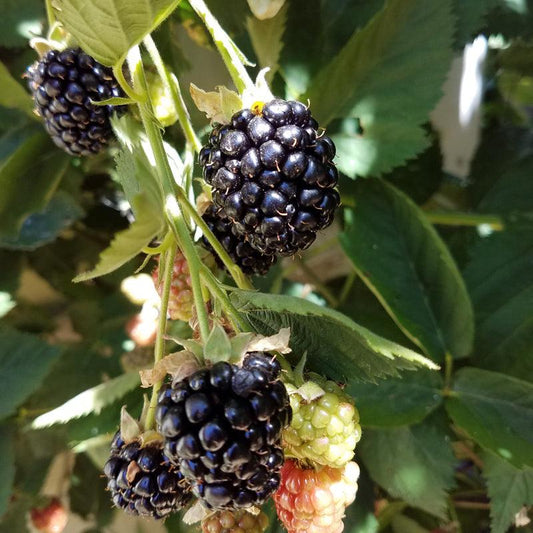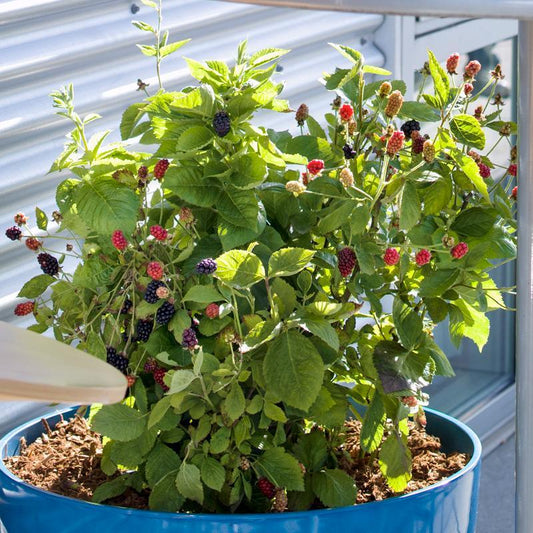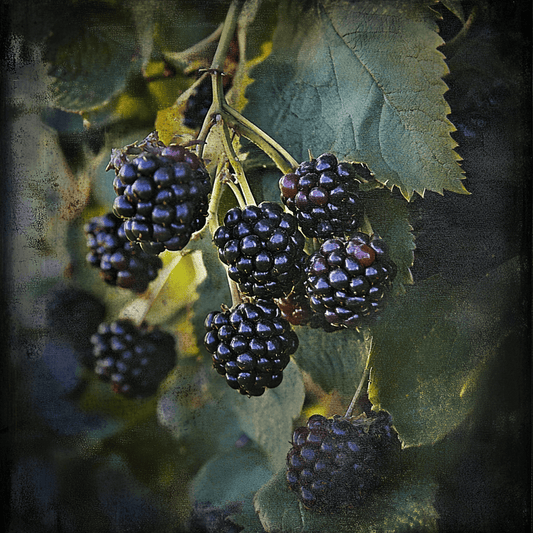Collection: Bareroot Blackberry Plants
Thornless & Trailing Blackberry Bushes & Plants for Home Gardeners
Find high‑quality blackberry bushes for sale, including bare root blackberries, bare root plants, and potted plants—perfect for home gardeners seeking delicious fruit with minimal hassle. Whether you want a blackberry bush for sale or blackberry plants for sale, our blackberry varieties include thornless, trailing, wild, and primocane fruiting types, all with excellent growth habit and strong root system for reliable yields.
Explore Our Blackberry Varieties
-
Chester Thornless Blackberry – A thornless blackberry bush, firm berries, great fresh or for storage.
-
Baby Cakes Blackberry – Compact, container‑friendly, ideal potted plants or small spaces.
-
Triple Crown Thornless Blackberry – Semi‑erect variety with large fruit and good disease resistance.
-
Marionberry – A classic trailing blackberry with rich flavor, perfect for pies and jam.
- Wild Blackberries – Hardy and vigorous, strong root systems; flavor and adaptability from wild stock.
Planting & Growth Essentials
- Best to plant bare root blackberry plants or bare root stock in early spring, while dormant.
- Select a sunny spot—full sun exposure is important for fruit set and berry size.
- Soil needs to be well‑drained, rich in organic matter, and support the root system effectively.
- Space blackberry bushes 3‑4 ft apart; trailing types need support structures, while erect ones may not.
Growth Habit & Maintenance
- Some varieties are primocane fruiting, producing fruit from first‑year canes; others fruit on year canes (second‑year canes).
- Remove old fruiting canes after harvest to make room for new growth.
- Prevent tip layering by keeping canes off the ground.
- When growing blackberries and raspberries together, watch out for cross‑diseases and shared pests.
Why Buy Our Blackberry Plants
- Wide selection: blackberry bushes for sale, bare root blackberries, potted plants, and more.
- Certified quality, selected for strong flavor, disease resistance, and excellent fruit production.
- Plants arrive with healthy root systems, ready to flourish.
- Suitable for various climates and spaces, including smaller gardens.
Resource Area: Blackberry Growing Guides & Tips
Here are helpful guides to support you in growing, caring for, and harvesting blackberry plants:
-
A Comprehensive Guide to Blackberry Varieties
→ Discover which blackberry varieties suit your climate, space, and flavor preference.
-
Blackberry Growing Guide
→ Extended advice on site prep, planting, pruning, and long‑term care of blackberry bushes.
-
How to Plant Cane Berries: A Growing Guide
→ Instructions for planting bare root blackberry plants and understanding cane types.
-
Harvesting and Usage of Blackberries: A Complete Guide
→ Tips for picking at peak ripeness and creative ways to use your berry harvest.
-
Planting and Growing Blackberries: A Comprehensive Guide
→ Step‑by‑step processes for planting, soil prep, spacing, and early care.
-
Blackberry Plant Care and Maintenance: A Complete Guide
→ All about pruning, fertilizing, and managing fruiting cycles.
-
Tips on Growing and Pruning Raspberries, Blackberries, and Boysenberries
→ How to prune thornless and wild bushes and maintain good habit and yield.
-
Pest and Disease Management for Blackberry Plants: A Complete Guide
→ Learn to protect your plants from common pests and diseases organically.
-
Seedless Blackberry Jelly Recipe
→ Using fresh blackberries in delicious seedless jelly—makes the harvest extra rewarding.
-
Dormant Pruning Your Blackberries & Raspberries
→ Pruning tips during dormancy to improve next year’s fruit production.
Ready to Grow Your Harvest?
Now’s the time to get started: browse our blackberry bushes for sale, bare root blackberry plants, and potted blackberry plants today. Plant in early spring, give them full sun, rich organic soil for a strong root system, and watch as your blackberry plants grow and start producing fruit season after season.












